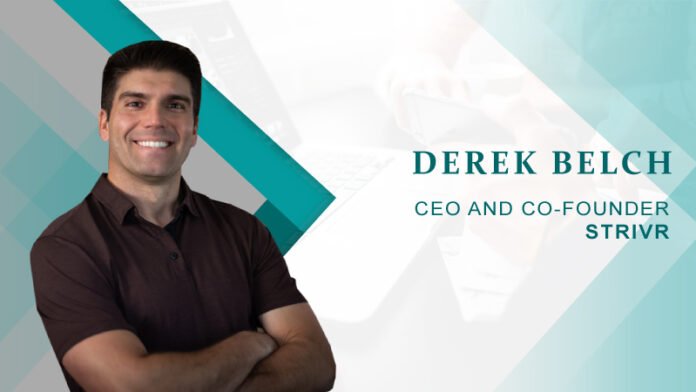Derek Belch, CEO and co-founder of Strivr, shares his insights on the utilization of VR for advancing learning and development opportunities for employees.
1. Tell us about your role in Strivr.
I am the CEO and co-founder of Strivr, provider of VR-based Immersive Learning solutions for Fortune 1000 companies and collegiate and professional sports teams.
2. Can you tell us about your journey into this market?
The Strivr founding story dates back to 2013, while I was pursuing my graduate degree and working as an assistant coach for the Stanford football team. During my first season, I “pitched” head coach David Shaw on a unique idea for my thesis… using Virtual Reality to help football players get “mental reps” as a complement to on-field practice work. David felt it was not only a cool idea as an academic requirement, but also something that could potentially help the team, so I partnered with Jeremy Bailenson – a Stanford professor and founder of the Virtual Human Interaction Lab – and got started on the project. The project took almost two years, and ended up being so successful that towards the end of the 2014 season Coach Shaw sat me down and gave me some advice… “If I were you, I’d get out of here and go start a company. And if you do, I’d love to invest.” Talk about a twist of fate! After much thought and discussion with my family, I took Coach’s advice and decided to give it a shot. Our last game was December 30, 2014, and on January 2, 2015, Strivr was born.
We initially started by providing VR-training for sports teams, and were successful very quickly. Within eight months of being in business, we had signed over twenty teams across the NFL and NCAA and a handful of teams in other sports like basketball and hockey. Strivr came to market with a bang, and everyone took notice.
About a year later, in the summer of 2016, I received a “fortuitous” phone call from a gentleman named Brock McKeel, Senior Director of Digital Operations at Walmart. Brock had just visited the University of Arkansas football facility, where he witnessed our technology in action with the players and immediately saw the potential applicability to training employees. Within a month of that phone call, we started a pilot program in the Walmart Academy system, and within 18 month we were in every one of Walmart’s 4,500+ stores in the United States. Since then, Strivr has conducted nearly 1.5 million training sessions in VR with Walmart and dozens of other enterprise partners such as Verizon, FedEx, Fidelity, and more.
3. How do you think technology is changing the HR Sector?
We see the most dramatic changes happening in L&D across companies of all shapes and sizes, but especially the Fortune 1000.
As automation becomes more prevalent, many employees must acquire new skills and knowledge to adapt to changing needs of the workforce.
This has driven the opportunity for technologies that can more efficiently and effectively respond to these upskilling and reskilling challenges. The ability to provide new data and insights into large-scale learning programs has also become incredibly valuable to HR leaders as they play a more strategic role in the business, helping to shape everything from hiring and onboarding to employee assessment, training, engagement, proficiency, and performance.
4. How has digitization eased the process of learning for employees, especially during times such as these?
Digitization has made L&D programs more accessible for employees and more scalable for companies than ever before. From company-provided webinars, videos, presentations, and Zoom calls to free online courses across several different platforms, employees can access a wealth of information from any computing device – laptop, phone, tablet, etc. – at any time. On the surface, this is a great thing for companies and employees, alike, but there are also some challenges associated with these forms of learning; digital fatigue, environmental distractions, and knowledge retention… to name a few.
5. What is the impact of immersive learning on employee training?
VR-based Immersive Learning is an example of an approach to learning that solves many digitization challenges by providing a safe, immersive, and realistic environment that is free of distractions and leads to the highest possible learning outcome. Immersive Learning modules are also designed to be interactive and repeatable, so employees can learn at their own pace or revisit to practice until they are confident and proficient. In addition, VR training has been proven time and again to have faster speed-to-proficiency and therefore higher ROI than traditional learning methods.
For Strivr, Immersive Learning has made an incredible impact on our customers’ L&D programs. For example, Walmart began using VR to train associates on a new process for in-store customer pick-up, and saw training times reduced from eight hours to just 15 minutes. For Verizon, associates across its approximately 1,600 retail stores in the U.S. learn the critical steps of de-escalating a high-risk scenario such as a store robbery. Of the associates that went through the training, 97% felt prepared when put in dangerous situations.
We have seen similar results across dozens of other Fortune 1000 companies for a variety of use cases, demonstrating that Immersive learning is a more engaging, efficient, and scalable platform for employee learning. With all of this in mind, to say that Immersive Learning has the power to be a transformative tool for HR organizations would actually be quite the understatement!
You can learn more about these case studies in our recently published ebook, which details more results and goes deeper on the impact that VR has had with our customers.
6. How can employee engagement be accelerated with predictive analytics?
Immersive Learning programs can offer unique insights into how employees are performing and where attention is being spent. For example, gaze-tracking capabilities can show where a store employee is looking while interacting with the learning module, which can help L&D professionals ensure that proper real-world safety measures are taken or customer service challenges are addressed. Data can also be tracked over time, enabling managers to help guide their teams on a path of continuous refinement and improvement. Because of the unique data opportunities associated with VR, Immersive Learning opens up numerous avenues in workplace assessment and training that classroom or seminar training models simply cannot achieve.
7. Why is VR significant in training employees on soft skills?
The immersive environments created by VR allow trainees to experience a phenomenon called “presence”, where the brian treats a virtual experience just as it would a real life experience. Studies have shown that this allows employees the opportunity to practice soft skills for situations that are hard to replicate in person, such as having difficult conversations, giving feedback, and identifying bias in a team environment.
As mentioned previously, VR also allows employees to be fully immersed in real-world scenarios, where they can practice soft skills in a “safe” environment. At Strivr, we like to say that “mistakes are free” in VR, meaning employees can practice and self-assess their skills in realistic, high-stress situations without the fear of negative consequence. VR allows the employee the opportunity to practice these scenarios again and again, such that they will become adept at properly handling them in the real world.
8. What is the process of partnering with Strivr and does it affect employee learning and performance?
Strivr offers an end-to-end solution and works closely with each company in a holistic approach to create an Immersive Learning curriculum that fits their specific needs. We follow a well-defined and proven strategy, allowing us to partner with our customers to move through strategy, curriculum design, content creation, hardware provisioning and deployment, and rollout/adoption. We use our expertise in VR, advanced learning theory, data science, and spatial design to inform important decisions throughout the process and ensure that successful and measurable learning is achieved at scale.
9. What differentiates your learning platform from others in the market?
Strivr’s Immersive Learning Platform enables the creation, delivery, and management of VR-based employee assessments and training across the entire employee journey (from hiring to upskilling/reskilling). Through more engaging experiences in VR, organizations can leverage Strivr’s platform at scale to assess learners, train skills, and predict an employee’s potential on-the-job performance. By combining unique training data with real world performance data, the platform provides the patented ability to measure training effectiveness, assess role potential, and predict learning outcomes.
More specifically, Strivr’s platform is based on a secure and compliant infrastructure to enable:
○ Intelligent authoring: Create immersive experiences rooted in behavioral science methodology and aligned with business + learning objectives
○ Content & device management at scale: Distribute and manage both Strivr and 3rd-party content, with provisioning and management of 3rd-party hardware devices.
○ Seamless in-headset experiences: Intuitive in-headset learning experience with data capture and self-assessment opportunities to improve learning outcomes.
○ Assessment & prediction: Leverage unique data capture to derive insights, assess role potential, and predict real-world performance based on immersive data.
○ Complete view of employee learning profile: Integration with existing enterprise systems of record (LMS, LRS, HCM) for enterprise-wide view of employee learning.
10. How do you prepare for an AI-centric World?
In the world of L&D, we are excited about the ways AI and natural language processing can come together to help improve Immersive Learning even more, such that we will be able to create seamless conversations with avatars and allow employees to interact with virtual environments even more in-depth than they do today. Not only will this make our soft skills simulations more advanced, but it will also help achieve our vision of using VR as a tool for powerful predictive analytics across the entire employee development lifecycle, from hiring to onboarding to training, and eventually “doing” the work in the real world.
11. What are the major developments you are planning, in recent times?
We believe that the future of work is immersive, such that Immersive Learning will play an important role in how we hire and train employees and eventually how they do the work. We believe the future will include a headset on every desk, and may become a reality much sooner than was thought in a pre-COVID world. Now,
the ability to bring a more engaging and consistent learning experience to employees regardless of location is more important than ever.
This is especially critical as soft skills become even more critical and valuable in communicating with and managing across a remote workforce.
12. Can you tell us about your team and how it supports you?
Drawing on my background as a collegiate athlete and a coach, we’ve worked hard to run Strivr like a “team sport”. Our leaders view our company like one big “puzzle”, where we’re constantly moving the pieces around to find the optimum fit, and “teamwork” is one of our core values. We embrace diversity of thought, perspective, and background, such that we never get too tunnel-visioned on one way of thinking or one way to solve a problem. Our Leadership Team is also unique, such that our company was initially built by several people that I’ve known since childhood or high school (including my own brother!). These people have evolved and played different roles throughout their time at Strivr, including humbly bringing more experienced people onto the team that we’d never met before but that we know would ultimately make us better. I’m proud of the fact that we’ve stayed true to our “roots” throughout the last six years… we started in sports, and make sure not to forget the lessons that team sports can teach us as we continue to work to achieve our vision.

For more such Updates Log on to www.hrtechcube.com

Derek Belch CEO and co-founder of Strivr
Derek Belch is the CEO and co-founder of Strivr, a provider of VR-based Immersive Learning solutions for Fortune 1000 companies and collegiate and professional sports teams. Strivr offers an end-to-end solution and works closely with each company in a holistic approach to create an Immersive Learning curriculum that fits their specific needs. The company has conducted nearly 1.5 million training sessions in VR with Walmart and dozens of other enterprise partners such as Verizon, FedEx, Fidelity, and more.













